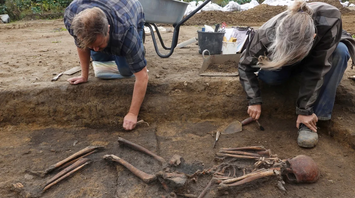Viking Age Burials in Denmark: A Rare and Fascinating Discover

Archaeologists in Denmark have recently made an astonishing discovery, unearthing more than 50 extraordinarily well-preserved Viking Age skeletons in Åsum, a village on the island of Funen, Live Science reported. This rare find occurred during preparations to lay electrical cables, covering approximately 21,500 square feet, and is estimated to date back to the 9th and 10th centuries. The site holds great significance due to the exceptional state of preservation attributed to the chalk and natural water found in the soil, conditions that greatly slow down bone decomposition.
The discovery includes a range of artifacts suggesting extensive Viking trade networks. Exceptional among the findings is a woman's burial in a rare Viking wagon, accompanied by items such as a beautiful glass bead necklace, an iron key, a silvery knife, potentially amuletic glass shards, and a finely decorated chest. Another notable grave contained a bronze three-lobed brooch, a red glass bead, an iron knife, and a rock crystal – an imported Norwegian item.
These graves date back to the reign of Danish kings Gorm "the Old" and Queen Thyra in the 900s. The site indicates Åsum's crucial role in early urban development preceding modern Odense. Michael Borre Lundø from Museum Odense, involved in the dig, highlighted the significance of uncovering so many skeletons in one place and noted that scientific analyses, including DNA extraction in Copenhagen, could reveal much about the health, diet, origins, and possibly familial ties of those buried.

This extraordinary discovery not only opens doors for understanding the Viking Age's individuals and their lifestyles but also emphasized the interconnectedness fostered by extensive trading networks of the time.
Earlier, SSP wrote that a study suggested new treatment for spinal cord injuries.



















